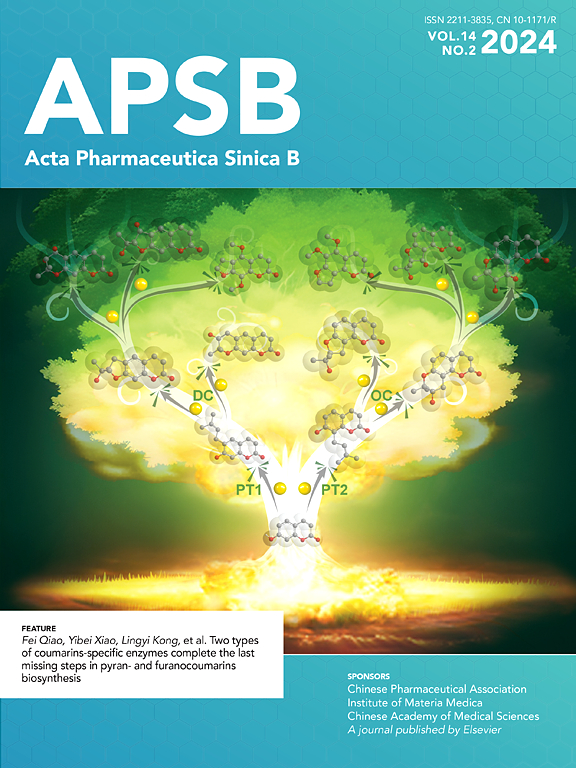帕金通过泛素化ACSL4和调节pufa -磷脂代谢来抑制铁超载诱导的心肌细胞铁下垂
IF 14.7
1区 医学
Q1 PHARMACOLOGY & PHARMACY
引用次数: 0
摘要
铁超载与心脏病密切相关。铁下垂是心脏缺血再灌注(I/R)损伤中一种新的细胞死亡形式。然而,心脏铁超载引起心肌损伤的具体分子机制尚不清楚,铁下垂在铁超载引起的心肌损伤中的作用尚不完全清楚。在这项研究中,我们观察到铁下垂参与了铁超载和I/ r诱导的心肌病的发展。在机制上,我们发现Parkin通过促进长链酰基辅酶a合成酶4 (ACSL4)的泛素化来抑制铁超载诱导的心肌细胞铁凋亡,ACSL4是参与铁凋亡相关脂质代谢途径的关键蛋白。此外,我们发现p53是一种转录因子,可转录抑制铁超载心肌细胞中的Parkin表达,从而调节铁超载诱导的铁下垂。在动物实验中,心脏特异性Parkin基因敲除小鼠(Myh6-CreERT2/Parkinfl/fl)饲喂高铁饮食后出现更严重的心肌损伤,高铁水平加重了心肌I/R损伤。然而,铁下垂抑制剂fe -1显著抑制铁超载诱导的铁下垂和心肌I/R损伤。此外,Parkin有效地保护线粒体功能受损,防止铁超载引起的线粒体脂质过氧化。这些发现揭示了p53 - parkinson - acsl4通过抑制铁下垂参与心脏病的新调控途径。本文章由计算机程序翻译,如有差异,请以英文原文为准。

Parkin inhibits iron overload-induced cardiomyocyte ferroptosis by ubiquitinating ACSL4 and modulating PUFA-phospholipids metabolism
Iron overload is strongly associated with heart disease. Ferroptosis is a new form of regulated cell death indicated in cardiac ischemia–reperfusion (I/R) injury. However, the specific molecular mechanism of myocardial injury caused by iron overload in the heart is still unclear, and the involvement of ferroptosis in iron overload-induced myocardial injury is not fully understood. In this study, we observed that ferroptosis participated in developing of iron overload and I/R-induced cardiomyopathy. Mechanistically, we discovered that Parkin inhibited iron overload-induced ferroptosis in cardiomyocytes by promoting the ubiquitination of long-chain acyl-CoA synthetase 4 (ACSL4), a crucial protein involved in ferroptosis-related lipid metabolism pathways. Additionally, we identified p53 as a transcription factor that transcriptionally suppressed Parkin expression in iron-overloaded cardiomyocytes, thereby regulating iron overload-induced ferroptosis. In animal studies, cardiac-specific Parkin knockout mice (Myh6-CreERT2/Parkinfl/fl) fed a high-iron diet presented more severe myocardial damage, and the high iron levels exacerbated myocardial I/R injury. However, the ferroptosis inhibitor Fer-1 significantly suppressed iron overload-induced ferroptosis and myocardial I/R injury. Moreover, Parkin effectively protected against impaired mitochondrial function and prevented iron overload-induced mitochondrial lipid peroxidation. These findings unveil a novel regulatory pathway involving p53–Parkin–ACSL4 in heart disease by inhibiting of ferroptosis.
求助全文
通过发布文献求助,成功后即可免费获取论文全文。
去求助
来源期刊

Acta Pharmaceutica Sinica. B
Pharmacology, Toxicology and Pharmaceutics-General Pharmacology, Toxicology and Pharmaceutics
CiteScore
22.40
自引率
5.50%
发文量
1051
审稿时长
19 weeks
期刊介绍:
The Journal of the Institute of Materia Medica, Chinese Academy of Medical Sciences, and the Chinese Pharmaceutical Association oversees the peer review process for Acta Pharmaceutica Sinica. B (APSB).
Published monthly in English, APSB is dedicated to disseminating significant original research articles, rapid communications, and high-quality reviews that highlight recent advances across various pharmaceutical sciences domains. These encompass pharmacology, pharmaceutics, medicinal chemistry, natural products, pharmacognosy, pharmaceutical analysis, and pharmacokinetics.
A part of the Acta Pharmaceutica Sinica series, established in 1953 and indexed in prominent databases like Chemical Abstracts, Index Medicus, SciFinder Scholar, Biological Abstracts, International Pharmaceutical Abstracts, Cambridge Scientific Abstracts, and Current Bibliography on Science and Technology, APSB is sponsored by the Institute of Materia Medica, Chinese Academy of Medical Sciences, and the Chinese Pharmaceutical Association. Its production and hosting are facilitated by Elsevier B.V. This collaborative effort ensures APSB's commitment to delivering valuable contributions to the pharmaceutical sciences community.
 求助内容:
求助内容: 应助结果提醒方式:
应助结果提醒方式:


